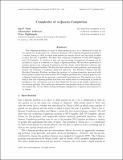Complexity of n-Queens Completion
Abstract
The n-Queens problem is to place n chess queens on an n by n chessboard so that no two queens are on the same row, column or diagonal. The n-Queens Completion problem is a variant, dating to 1850, in which some queens are already placed and the solver is asked to place the rest, if possible. We show that n-Queens Completion is both NP-Complete and #P-Complete. A corollary is that any non-attacking arrangement of queens can be included as a part of a solution to a larger n-Queens problem. We introduce generators of random instances for n-Queens Completion and the closely related Blocked n-Queens and Excluded Diagonals Problem. We describe three solvers for these problems, and empirically analyse the hardness of randomly generated instances. For Blocked n-Queens and the Excluded Diagonals Problem, we show the existence of a phase transition associated with hard instances as has been seen in other NP-Complete problems, but a natural generator for n-Queens Completion did not generate consistently hard instances. The significance of this work is that the n-Queens problem has been very widely used as a benchmark in Artificial Intelligence, but conclusions on it are often disputable because of the simple complexity of the decision problem. Our results give alternative benchmarks which are hard theoretically and empirically, but for which solving techniques designed for n-Queens need minimal or no change.
Citation
Gent , I P , Jefferson , C A & Nightingale , P W 2017 , ' Complexity of n -Queens Completion ' , Journal of Artificial Intelligence Research , vol. 59 , pp. 815-848 . https://doi.org/10.1613/jair.5512
Publication
Journal of Artificial Intelligence Research
Status
Peer reviewed
ISSN
1076-9757Type
Journal article
Collections
Items in the St Andrews Research Repository are protected by copyright, with all rights reserved, unless otherwise indicated.

